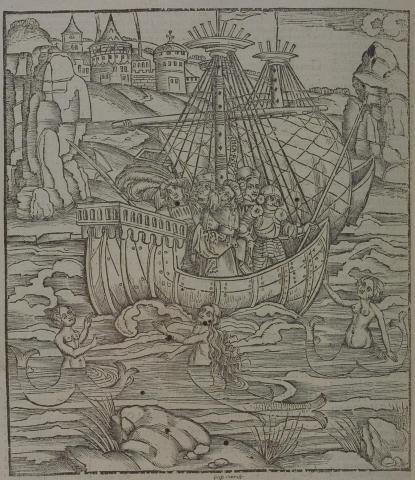Annotations
Three nymphs, from Aeneas's recently transformed fleet, approach Aeneas in his ship (219-24). The three nymphs share the tasks which Virgil assigns to the one nymph, Cymodocea (225). The nymph on the left stops the ship with a touch of her finger to the front (226), the one in the middle informs Aeneas of what has happened in his city while he was away (228-45), and the one on the right, gives the ship a push to speed it along to its destination. Aeneas, who for some reason is labeled here as Aeneas Rex, King Aeneas, looks to the sky in a prayer of thanks to Cybele, the goddess who sent the nymphs to him (251-4). In this illustration, it appears that Aeneas's men are awake and have heard what the nymphs have to say, though the text implies that Aeneas is the only man awake, at least on his ship (217-8).
Woodcut illustration from the “Strasbourg Vergil,” edited by Sebastian Brant: Publii Virgilii Maronis Opera cum quinque vulgatis commentariis expolitissimisque figuris atque imaginibus nuper per Sebastianum Brant superadditis (Strasbourg: Johannis Grieninger, 1502), fol. 354v, executed by an anonymous engraver under the direction of Brant.


Sebastian Brant (1458-1521) was a humanist scholar of many competencies. Trained in classics and law at the University of Basel, Brant later lectured in jurisprudence there and practiced law in his native city of Strasbourg. While his satirical poem Das Narrenschiff won him considerable standing as a writer, his role in the transmission of Virgil to the Renaissance was at least as important. In 1502 he and Strasbourg printer Johannes Grüninger produced a major edition of Virgil’s works, along with Donatus’ Life and the commentaries of Servius, Landino, and Calderini, with more than two hundred woodcut illustrations. (Annabel Patterson)